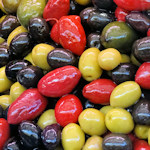
“If you’re tired of schnitzel, you’re tired of life”, they should probably say in Vienna. But if you do fancy eating something that isn’t fried pork, then the Naschmarkt is a top option.
- Huge open-air food and gourmet market
- Also home to numerous bars and restaurants
- Multicultural and international ambience
- Popular haunt for warm days and evenings
- Book a spot on a culinary tour* of the Naschmarkt
- See also:
What is the Naschmarkt?
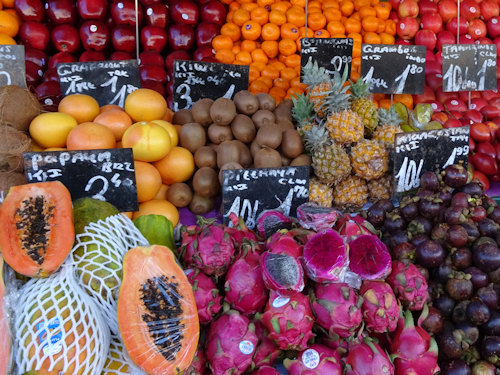
(Fruit from far and near)
Vienna has numerous permanent markets, but the Naschmarkt counts as the biggest and most famous. It even featured in the Amazon romcom, Sachertorte.
This is a place for pepinos and papayas, kiwis and kiwanos. You want olives? Name your size, colour and flavour. Got a craving for cassava? Step this way my friend. And why not pick up a yam while you’re here?
Built over the River Wien, which runs underground in this part of the city, the market has two main alleyways…one dominated by restaurants, the other by food stores and stalls.
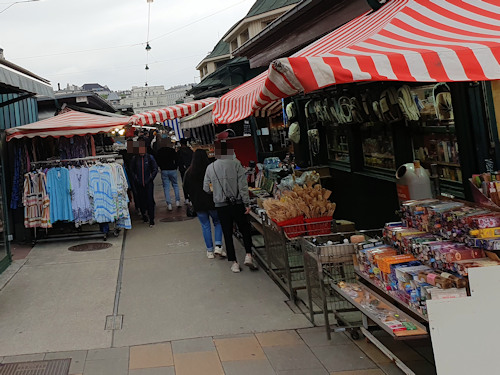
(Tight alleys create a market buzz at busy times)
Drift down the main food alleyway and take in the colours and smells of the produce while the market traders desperately encourage customers to add another ox heart tomato to their shopping list.
Try then buy
I used to take my kids in their prams, and stand owners would rush over to give them a free falafel or something sticky, sweet and definitely not found in your average Viennese supermarket.
As you wind your way past mountains of olives and octopus, prepare to be greeted with a stuffed pepper or a sliver of salami to taste.
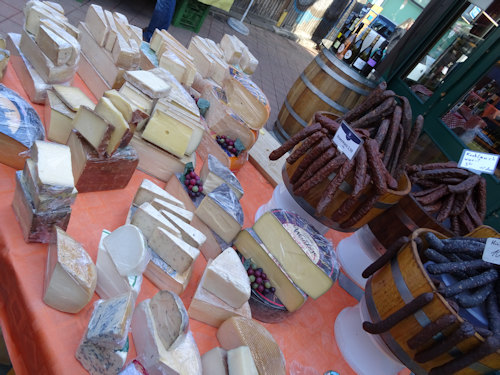
(Cheese and sausages: two of Vienna’s main interests)
The food stalls themselves are mainly a mix of local gourmet offerings and stalls featuring food and ingredients that trace their origins back to Ottoman cuisine, with a splash of India, the Americas, China, and elsewhere thrown in for good measure.
For example, you’ll find row after row of Baklava (a sweet dish made from filo pastry), which has its roots in Roman cooking and the Topkapi Palace kitchens of Istanbul.
Stuffed dates jostle for space with exotic herbs, spices, pickles, dried fruits, and nuts. And even the innocent fruit and veg stalls hold a few surprises, like Indian snake fruit.
Cheese lover? Suffice to say my recovery from a Stilton addiction ended after I went to the Naschmarkt.
And if you’re looking for even more protein, visit the butcher stalls selling such delights as wild boar, pheasant, and venison.
The Naschmarkt is big on seafood too: sole and sturgeon, king crabs and catfish, organic salmon and Argentinian giant shrimps, to name but a few of the products typically on offer.
The gourmet alleyway
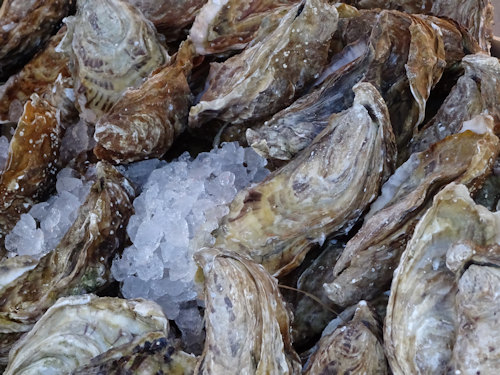
(Oysters just one of many varieties of seafood available)
Although technically a food market, a sizeable minority of stands and locations are now places to eat.
In good weather, guests fill the outdoor tables as they enjoy food from around the world and a glass of chilled wine or beer.
So you have a choice: eat, for example, a sumptuous seafood platter on site or buy the ingredients and make your own later.
History
The Naschmarkt began life around the 1770s, mainly as a milk market, and located in front of a large aristocratic property outside the then city walls.
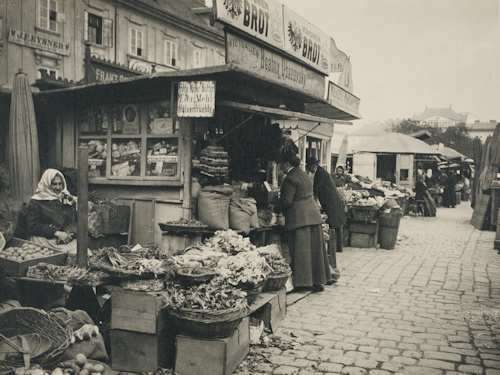
(The stand of Beatrix Oberovsky, dealer of victuals, on the old Naschmarkt. One sign advertises bread, another genuine natural butter, eggs, flour and pulses. Photographed by Moriz Nähr around 1885; Wien Museum Inv.-Nr. 39551/9; excerpt reproduced with permission under the terms of the CC0 licence)
The market’s big moment came in 1793, when the authorities declared that any fruit and vegetables not brought into Vienna along the Danube had to be traded at this location. Which had an inevitable impact on the value of a market stand.
Things progressed more or less happily until the start of the 20th century and a forced relocation due to water regulation works on the River Wien.
The market moved a little to the north and west to its present home, sandwiched between the Linke Wienzeile and Rechte Wienzeile roads that carry traffic along the river’s route.
All of which sounds simple, but the phased transfer wasn’t fully completed until 1916. The pavilions have remained largely untouched since, and the market completed its latest refit in 2015.
Opening times & visitor tips
The Naschmarkt includes dozens of fixed stands and pavilions, as well as temporary areas. They begin opening around 6 in the morning on weekdays and close by about 7.30 in the evening, though some stands may open longer (as do the cafés and restaurants, of course).
Saturday sees the stands close early, around 5-6pm, and the market stays closed on Sundays.
Some tips:
- The area adjoining the southwest edge of the market hosts a large flea market most Saturdays.
- It might be best to visit the market at a busy time, like Saturday mornings. More of the stalls are open and the bustle adds to the atmosphere, if you don’t mind making slow progress down the narrow market aisles.
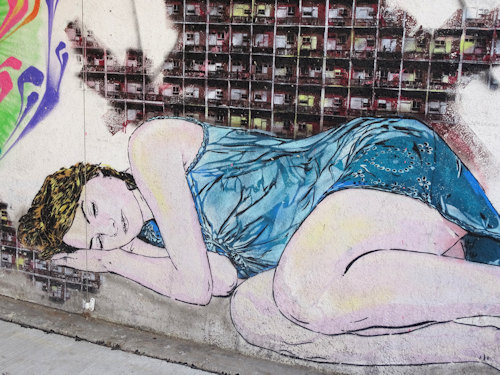
(Street art spotted around the back of the stalls)
- Go down the main restaurant aisle toward the Kettenbrückengasse station and carry on once the restaurants stop. You end up in a quiet area behind the food stalls, where street art, empty racks and stores of produce make great photo motifs.
- The area around the Naschmarkt is also rich in restaurants and coffee houses. If the market is too crowded for you, take refuge in one of the establishments nearby.
Café Sperl is just around the corner, for example: one of Vienna’s more famous traditional coffee houses and a film location for the Vienna Blood period detective series.
The surrounding area has a few other attractions. For example:
- Over the road from the Karlsplatz end of the market is the Secession building, home to the famous Beethoven Frieze by Gustav Klimt.
- The Naschmarkt runs alongside the Majolikahaus (a turn-of-the-century town house designed by Otto Wagner and possessing a famous coloured façade) and the Theater an der Wien opera house
- The Third Man Museum lies just a couple of blocks away
How to get to the Naschmarkt
Subway: Take the U4 to Kettenbrückengasse, or the U1, U2 or U4 to Karlsplatz (and a short walk)
Tram/bus: Take the 1 or 62 tram to Resselgasse and walk across to the market. Or take bus 59A to Bärenmühldurchgang or Preßgasse
Address: Naschmarkt, 1060 Vienna